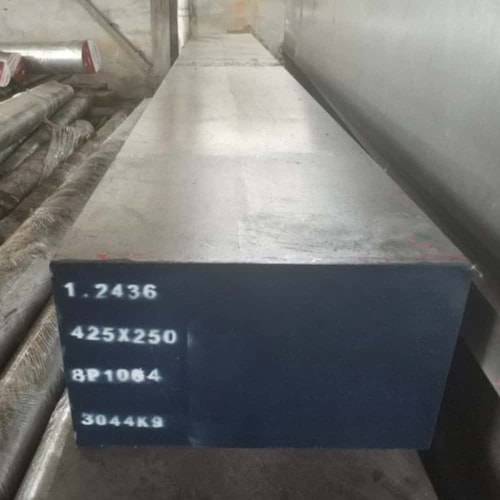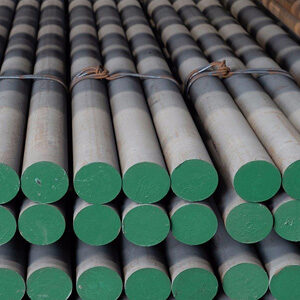Introduction

Tool steels are indispensable in modern manufacturing, offering superior properties such as hardness, wear resistance, and toughness. Among these, Tool Steel 1.2436 (X210CrW12) stands out for its exceptional hardness and suitability for cold work applications. This blog delves into the detailed properties, diverse applications, advantages, and key considerations of using Tool Steel 1.2436.
Properties of Tool Steel 1.2436
Tool Steel 1.2436 is characterized by its high carbon (C), chromium (Cr), and moderate tungsten (W) content. These elements contribute to its remarkable hardness, wear resistance, and toughness. Typically achieving hardness in the range of 58-62 HRC (Rockwell hardness scale), 1.2436 Tool Steel is favored for applications requiring high abrasive wear resistance and good dimensional stability during heat treatment.
Detailed Properties:
- Chemical Composition: Contains approximately 1.55% carbon, 12% chromium, and 0.6% tungsten.
- Hardness: Typically hardened to 58-62 HRC, providing excellent resistance to wear and deformation.
- Toughness: Despite its high hardness, 1.2436 Tool Steel exhibits good toughness, crucial for withstanding impact loads.
- Wear Resistance: Maintains its sharp edge and dimensional stability under high-stress conditions.
- Machinability: Moderate machinability due to its high hardness; requires tools and techniques suited for hard materials.
Applications in Various Industries
Tool Steel 1.2436 finds extensive use across diverse industries where precision, durability, and reliability are paramount. Its properties make it particularly suitable for the following applications:
- Tool and Die Making:
- Cold Work Tools: Used in the manufacture of punches, dies, and other cutting tools where high hardness and wear resistance are critical.
- Press Tools: Applications include blanking, bending, and forming tools requiring excellent edge retention and toughness.
- Plastic Molding:
- Injection Molding Dies: Due to its high wear resistance and polishability, 1.2436 Tool Steel is ideal for producing precise and durable molds.
- Woodworking:
- Cutting Tools: Saw blades and woodworking knives benefit from 1.2436 Tool Steel’s ability to maintain a sharp edge and resist wear during high-speed cutting operations.
- Metal Forming:
- Stamping Dies: Used in automotive and aerospace industries for forming metal parts with intricate shapes, requiring both hardness and toughness.
Advantages of Tool Steel 1.2436
Tool Steel 1.2436 offers several advantages that contribute to its widespread adoption in manufacturing:
- High Hardness: Maintains hardness even at elevated temperatures, ensuring long-term durability and wear resistance.
- Excellent Wear Resistance: Resists abrasive wear, prolonging tool life and reducing downtime for maintenance.
- Good Toughness: Provides sufficient toughness to withstand impact and shock loads, reducing the risk of tool failure.
- Edge Retention: Retains a sharp cutting edge, crucial for maintaining precision in machining and forming operations.
Considerations When Using Tool Steel 1.2436
While Tool Steel 1.2436 offers exceptional performance, certain considerations should be taken into account for optimal use:
- Machining: Due to its high hardness, machining Tool Steel 1.2436 requires specialized tools and techniques capable of handling hard materials.
- Heat Treatment: Proper heat treatment is critical to achieve the desired hardness and toughness, ensuring optimal performance in specific applications.
- Surface Finish: Polishability may be necessary for applications requiring smooth surface finishes, such as in plastic molding and fine blanking.
Case Studies and Practical Examples

To illustrate its versatility and effectiveness, consider these practical examples of Tool Steel 1.2436 applications:
- Case Study : Tool Steel 1.2436 used in the production of precision injection molding dies for high-volume manufacturing of plastic components.
- Case Study : Application in the manufacturing of industrial cutting tools where high wear resistance and dimensional stability are essential for prolonged tool life.
Conclusion
In conclusion, Tool Steel 1.2436 plays a vital role in modern manufacturing due to its exceptional hardness, wear resistance, and toughness. Its versatility allows it to be employed across various industries, from tool and die making to plastic molding and metal forming. By understanding its properties, applications, advantages, and considerations, manufacturers can effectively utilize Tool Steel 1.2436 to enhance productivity, improve tool performance, and achieve higher quality standards in their manufacturing processes.
FAQ
Q: What is the maximum achievable hardness with Tool Steel 1.2436?
A: Tool Steel 1.2436 can typically achieve a hardness of 58-62 HRC, depending on the specific heat treatment process.
Q: How does 1.2436 Tool Steel compare to other tool steels in terms of toughness?
A: It exhibits good toughness despite its high hardness, making it suitable for applications requiring both wear resistance and impact strength.
Q: Can Tool Steel 1.2436 be welded?
A: Weldability is limited due to its high carbon content. Preheating and post-weld heat treatment are recommended to minimize cracking and ensure weld integrity.

